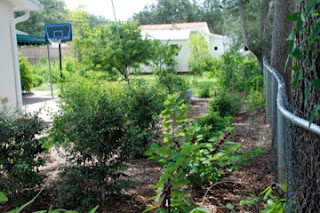 |
| Tropical Buckeye, photo by Linda Cooper |
 |
| Mimosa Yellow, photo by Hank Poor |
 |
| Florida Purplewing, photo by Ron Nuehring |
 |
| Dingy Purplewing, photo by Ron Nuehring |
 | |
| Florida White, photo by Hank Poor |
One of our Miami Blue Chapter’s centerpiece conservation projects looks like we’re having TOO MUCH FUN! After all, it’s a lot like going butterflying. But with a purpose.
We often go to little known places (be honest, how many of you really know where Rock Pit 39 in Miami-Dade County is?) and locations that require special access such as restricted federal and military properties. We carry GPS units and cameras and carefully record numbers butterflies seen. We sometimes do some bush-whacking, trying to find host plants that may be out of view off the trail. (Yes, we wear long pants and protective foot gear and watch where we put our feet.)
So what are we up to? The Florida Natural Areas Inventory (FNAI; www.fnai.org) is a state-funded project based in Tallahassee that aims to catalog Florida’s imperiled species of plants and animals. Identifying populations of rare, endangered species is the basis for land management strategies that can ensure protection of the species; you can’t protect it if you don’t know it’s there.
FNAI has a butterfly component, which has listed 75 butterflies and moths as imperiled, based on their vulnerability to extinction due to natural and/or human-caused factors or highly restricted ranges. Of the 75, over a third are South Florida species.
Our task now is to locate populations of our 25+ imperiled South Florida species in order to promote their protection.
Some of our imperiled species are hammock and hammock-edge specialists such as the Schaus’ Swallowtail, Florida White, Dina Yellow, Mimosa Yellow, Dingy Purplewing, and Florida Purplewing. Some are pine rockland specialists such as the Florida Leafwing, Bartram’s Scrub-Hairstreak, and Florida Duskywing. Some are declining wetland species such as Berry’s Skipper. A full list of South Florida species considered to be in trouble can be found at http://www.miamiblue.org/conservation.php.
In 2010, FNAI received three years of funding to support imperiled butterfly surveys in South Florida and our local NABA chapters, Miami Blue Chapter (MBC), Broward Butterflies, and Itala Chapter of Palm Beach set to work. All our effort in the field involves volunteer NABA chapter members.
In Miami-Dade County FNAI listed over 150 parks, preserves and conservation lands with potential for protective management of imperiled butterflies. Another approximately 43 such sites are in Monroe County.
MBC first grouped our counties' identified sites into clusters to facilitate efficient travel. We next recruited several chapter members with good field skills, or the desire to develop them, and tried to link members with clusters of sites that would be convenient for them to visit, possibly multiple times. While FNAI is seeking only to determine if a species is present or absent in a site, we find that some sites will require repeat visits; for example, we may find abundance of host plants but no butterflies at any life cycle stage, suggesting follow-up at a later time.
We then began to sharpen our field skills. Most members who have volunteered are reliable identifiers of adult butterflies, but we need help spotting and identifying eggs, caterpillars, and chrysalids. We held our first workshop to hone these abilities on April 23 2011 and are grateful to Dr. Marc Minno for spending a thoroughly productive day with us.
As a chapter, we expect to focus several of our customary field trips on our FNAI sites and to collaborate more frequently with our local Dade Native Plant Society on field trips. Our friends in the DNPS have much to offer us in recognizing some of the more cryptic host plants used by some of our imperiled butterflies.
What about sightings in areas other than FNAI’s specified conservation areas? For example, Dina Yellows show up in people’s yards where Bitterbush and Mexican Alvaradoa are cultivated. Hence, butterfly gardeners can contribute records of rare butterflies seen on their own properties. In most cases, this means learning to recognize a small number of species, which you may already know well, and emailing simple reports to the chapter at miamiblue@bellsouth.net.
Some of us regularly patrol specific areas. Maybe it’s a botanical garden where you volunteer. Maybe it’s a park near your home where you dog walk. Maybe you just go butterflying on a routine basis at a place you particularly enjoy. People who regularly visit a particular location can document rare species seen at their favorite site. Similar to yards, this usually means learning to recognize a few target species and emailing reports to miamiblue@bellsouth.net.
Some of us just have that “third eye” peeled for butterflies wherever we go. A Silver-banded Hairstreak has been seen and photographed on North Key Largo at the edge of a parking lot of a visitor center – seen by alert observers in an unlikely place.
FNAI is interested in all these occurrences and MBC is encouraging anyone who can supply a photo (even a “bad” photo) and an address or clear description of the location to send their sighting to miamiblue@bellsouth.net. Didn’t get a photo? Go ahead and email us anyway – perhaps your description will be helpful. Not sure what species to be looking for? Check the list on our web site: http://www.miamiblue.org/conservation.php.
If you would like to learn more about our FNAI survey project, email miamiblue@bellsouth.net and we will contact you with additional details about being part of a team, gas mileage reimbursement, etc.



















